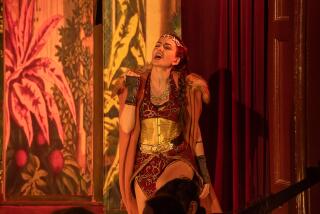Europa Galante requires keen ears at Disney Hall
- Share via
Fabio Biondi and members of his period-performance-practice band, Europa Galante, opened Walt Disney Concert Hall’s second “Baroque Variations” series Sunday night -- and here, one had to suspend a certain amount of disbelief. If the goal of these Italian musicians is to approximate the sounds 18th century composers heard, it was somewhat anachronistic to hear them in this ultra-modern venue.
On the other hand, Disney Hall did provide a reality check of sorts: volume level. Period instruments do not produce as much sound as modern ones -- and Europa Galante sounded startlingly dim in this live hall. Yet that was probably a more honest impression than we get from the group’s recordings on our cranked-up home stereos.
Europa Galante can turn up in combinations ranging from four to 30 musicians, but for this program of 18th century orchestral pieces from Italy and Germany, a group of 10 string players and one harpsichord continuo was deployed throughout. The tempos were mostly fast, the playing full of vigor and commitment, yet the textures were paradoxically thick, and details weren’t always clear even in this notoriously analytical acoustical space. Biondi himself is a remarkably agile violin soloist. He played Vivaldi’s Concerto in D major, Opus 3, No. 9, with dash and fire in the outer movements and openly lyrical sentiments in the slow movement.
There was more from Vivaldi’s bottomless archive -- the Concerto in D major for two violins and two cellos, RV 564 -- along with Corelli’s Concerto Grosso in D major, Opus 6, No. 4 and a Geminiani concerto grosso based upon Corelli’s “Follia” Sonata.
The most interesting pieces, though, came from the Germans. Telemann’s “Burlesque de Quixotte” was an imaginative Baroque tone poem depicting the adventures of Don Quixote more than a century before Richard Strauss had the idea; it was played with a driving, appealingly rough peasant feeling. And W.F. Bach’s Sinfonia in F major (“Dissonances”) was as good as its word, with brusque dissonances in the first movement and premonitions of Mozart and even Beethoven later on.
As encores, Europa Galante offered a tiny, delectable pizzicato Allegro from Gluck’s “Don Giovanni” ballet -- where at last, Disney Hall’s solid bass response could be felt -- and a repeat of the Corelli concerto’s final movement.
More to Read
The biggest entertainment stories
Get our big stories about Hollywood, film, television, music, arts, culture and more right in your inbox as soon as they publish.
You may occasionally receive promotional content from the Los Angeles Times.










